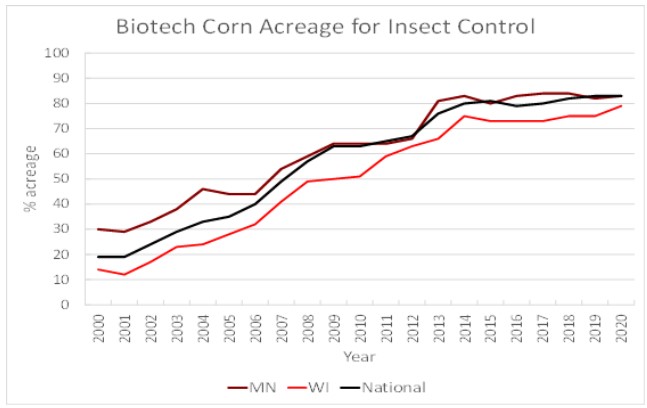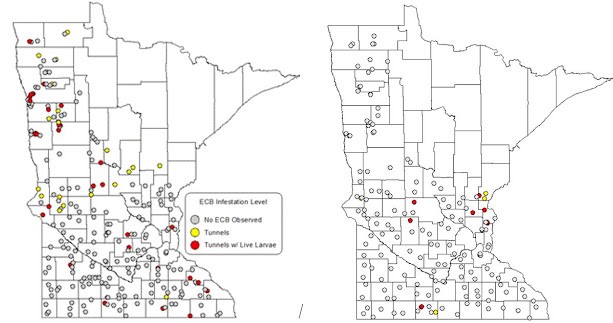By Bruce Potter and Ken Ostlie et.al
The recent economics of corn production have challenged many farmers to minimize production costs. Hybrid selection is one way to reduce costs. Planting corn hybrids without Bacillus thuringiensis (Bt) proteins for protection against European corn borer (ECB), corn rootworm, or both will reduce seed costs. However, if not careful, farmers could inadvertently reduce crop revenues, if they select hybrids without considering yield potential or insect populations in their fields.
Yield potential is the first thing to consider when selecting a corn hybrid. Bt traits protect the yield potential of a hybrid, but yield benefits only occur when targeted insect population densities are above economic injury levels.
When insect pressure is low or absent, economic benefit with trait-protected hybrids only occurs if higher costs are offset by greater yields. Switching to less-expensive non-Bt seed can be a good strategy when yields are comparable or when seed cost savings exceed any reduced yield potential plus prospective insect losses. In many 2021 fields, planting corn without a Bt trait can work well, if you recognize and account for your insect risk.
Historical, current, and future ECB populations
Since the adoption of Bt corn 25 years ago, Bt use rates in Minnesota have grown to as high as 85% of the total acres planted in 2017. During 2020, Bt hybrids comprised 83% of Minnesota corn acres, identical to the national average (Figure 1).

Figure 1. Adoption of Bt corn hybrids. The Bt varieties include those that contain more than one gene that can resist different types of insects (e.g., European corn borer; corn rootworms) since 2000. Source: USDA, Economic Research Service using data from USDA, National Agricultural Statistics Service, June Agricultural Survey as published in the NASS report Acreage.
ECB populations in Minnesota and throughout most of the Midwest have been effectively suppressed by similar adoption rates of Bt. ECB populations continue to be low in Minnesota where Bt use has remained high since 2007. Low ECB moth flights (Figure 2) parallel the low ECB larval population densities detected in the fall surveys (Figures 3-5). Low ECB population densities have also been documented in Wisconsin, where Bt adoption rates remain high as well (Figure 1).
Figure 2. MN black-light trap ECB captures for 2020. The June peak corresponds to 1st generation and the mid- August to September flight corresponds to the 2nd generation. The 2nd generation ECB flight can overlap the univoltine moth flights that occur in July to August. Moths continued to be trapped at historically low numbers, for all locations.
During 2017-20, the MN Corn Research and Promotion Council provided funding to increase the number of fields surveyed for overwintering larvae (Figure 3) and ECB damage (Figure 4). During 2020, 166 randomly selected commercial fields were evaluated for the presence of overwintering ECB larvae. Fall overwintering larval population densities in WC and NW Minnesota were somewhat lower in 2020 than in previous years.
Figure 3. Historical overwintering fall ECB populations (1995-1997) comparing a pre-Bt era infestation peak (1995), with the early years of commercialization (1996-1997), and with recent years (2018-2020).
Figure 4. Changes in ECB damage (tunneling) from 2018-2020.
Overall, 2020 ECB infestation levels observed were similar to 2016-2019 (Table 1, Figure 5) and remain at near historically low levels, averaging 0.012 larvae/plant. These data compare to the state average overwintering larval number in random samples of 0.0039/plant in 2019, 0.0080/plant in 2018, 0.0054/plant in 2017, and 0.016/plant in 2016. The average density in non-Bt fields remains much lower than the traditional economic threshold levels for ECB (typically greater than 0.5 larvae/plant). It is important to remember that these numbers are state averages, and the maps represent interpolated spatial data and do not reflect the densities within an individual field. In other words, they do not replace scouting for field-specific decisions.
Table 1. Statewide data for European corn borer larvae in field corn, 2017 - 2020.
| Year | Mean ECB larvae/plant
(n) |
|---|
| 2017 | 0.0054 (147) |
| 2018 | 0.0080 (137) |
| 2019 | 0.0039 (152) |
| 2020 | 0.0120 (166) |

Figure 5. Relative location of fields sampled in 2019 (left) and 2020 (right) for ECB. Legend: Gray - no ECB detected, Yellow - tunnels only (no larvae), Red - tunnels with larvae.
From an area-wide and long-term resistance management view, it is prudent to maintain susceptible ECB in the state. Non-Bt, or “refuge,” corn should produce moths that reflect the resistance level found in the local ECB population. When Bt-resistance levels are low, non-Bt corn fields will produce primarily susceptible moths. Any moths that emerge from non-Bt fields should theoretically have experienced less Bt selection pressure and ideally will most likely mate with the rarer resistant moths that survive from Bt fields. Such matings are therefore designed to assist in keeping the frequency of resistance genes low, and functionally recessive. The subsequent ideal outcome is that susceptible genes dominate over time and help conserve the Bt technology long as possible. For ECB, this continues to be one of the ongoing success stories with Bt traits. The 2020 fall survey did not reveal any fields with suspected Bt-resistance, and the prolonged low populations levels suggest the Bt-ECB traits continue to work well.